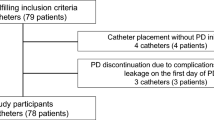Abstract
Background
This study aimed to evaluate outcome of children on chronic peritoneal dialysis (PD) with a concurrent colostomy.
Methods
Patients were identified through the International Pediatric Peritoneal Dialysis Network (IPPN) registry. Matched controls were randomly selected from the registry. Data were collected through the IPPN database and a survey disseminated to all participating sites.
Results
Fifteen centers reported 20 children who received chronic PD with a co-existing colostomy. The most common cause of end stage kidney disease was congenital anomalies of the kidney and urinary tract (n = 16, 80%). The main reason for colostomy placement was anorectal malformation (n = 13, 65%). The median age at colostomy creation and PD catheter (PDC) insertion were 0.1 (IQR, 0–2.2) and 2.8 (IQR 0.2–18.8) months, respectively. The colostomies and PDCs were present together for a median 18 (IQR, 4.9–35.8) months. The median age at PDC placement in 46 controls was 3.4 (IQR, 0.2–7.4) months of age. Fourteen patients (70%) developed 39 episodes of peritonitis. The annualized peritonitis rate was significantly higher in the colostomy group (1.13 vs. 0.70 episodes per patient year; p = 0.02). Predominant causative microorganisms were Staphylococcus aureus (15%) and Pseudomonas aeruginosa (13%). There were 12 exit site infection (ESI) episodes reported exclusively in colostomy patients. Seven colostomy children (35%) died during their course of PD, in two cases due to peritonitis.
Conclusion
Although feasible in children with a colostomy, chronic PD is associated with an increased risk of peritonitis and mortality. Continued efforts to reduce infection risk for this complex patient population are essential.


Similar content being viewed by others
References
Harambat J, Van Stralen KJ, Kim JJ, Tizard EJ (2012) Epidemiology of chronic kidney disease in children. Pediatr Nephrol 27:363–373
Zurowska AM, Fischbach M, Watson AR, Edefonti A, Stefanidis CJ, European Paediatric Dialysis Working Group (2013) Clinical practice recommendations for the care of infants with stage 5 chronic kidney disease (CKD5). Pediatr Nephrol 28:1739–1748
Watson AR, Hayes WN, Vondrak K, Ariceta G, Schmitt CP, Ekim M, Fischbach M, Edefonti A, Shroff R, Holta T (2013) Factors influencing choice of renal replacement therapy in European paediatric nephrology units. Pediatr Nephrol 28:2361–2368
Giuliani S, Midrio P, De Filippo RE, Vidal E, Castagnetti M, Zanon GF, Gamba PG (2013) Anorectal malformation and associated end-stage renal disease: management from newborn to adult life. J Pediatr Surg 48:635–641
DeFoor WR, Bischoff A, Reddy P, VanderBrink B, Minevich E, Schulte M, Sheldon C, Peña A (2015) Chronic kidney disease stage progression in patients undergoing repair of persistent cloaca. J Urol 194:190–194
Van der Steeg H, Schmiedeke E, Bagolan P, Broens P, Demirogullari B, Garcia–Vazquez A, Grasshoff-Derr S, Lacher M, Leva E, Makedonsky I (2015) European consensus meeting of ARM-Net members concerning diagnosis and early management of newborns with anorectal malformations. Tech Coloproctol 19:181–185
Chadha V, Jones L, Ramirez Z, Warady B (2000) Chest wall peritoneal dialysis catheter placement in infants with a colostomy. Adv Perit Dial 16:318–320
Aksu N, Yavascan O, Anil M, Kara OD, Bal A, Anil AB (2012) Chronic peritoneal dialysis in children with special needs or social disadvantage or both: contraindications are not always contraindications. Perit Dial Int 32:424–430
Zaritsky JJ, Hanevold C, Quigley R, Richardson T, Wong C, Ehrlich J, Lawlor J, Rodean J, Neu A, Warady BA (2018) Epidemiology of peritonitis following maintenance peritoneal dialysis catheter placement during infancy: a report of the SCOPE collaborative. Pediatr Nephrol 33:713–722
Warady BA, Bakkaloglu S, Newland J, Cantwell M, Verrina E, Neu A, Chadha V, Yap H-K, Schaefer F (2012) Consensus guidelines for the prevention and treatment of catheter-related infections and peritonitis in pediatric patients receiving peritoneal dialysis: 2012 update. Perit Dial Int 32(Suppl 2):S32–S86
Sethna CB, Bryant K, Munshi R, Warady BA, Richardson T, Lawlor J, Newland JG, Neu A, SCOPE Investigators (2016) Risk factors for and outcomes of catheter-associated peritonitis in children: the SCOPE collaborative. Clin J Am Soc Nephrol 11:1590–1596
Bischoff A, Levitt MA, Peña A (2013) Update on the management of anorectal malformations. Pediatr Surg Int 29:899–904
Ahn S-Y, Mendoza S, Kaplan G, Reznik V (2009) Chronic kidney disease in the VACTERL association: clinical course and outcome. Pediatr Nephrol 24:1047–1053
North American Pediatric Renal Trials and Collaborative Studies (2011) Annual Dialysis Report (2011). https://web.emmes.com/study/ped/annlrept/annualrept2011.pdf
Swartz SJ, Neu A, Mason AS, Richardson T, Rodean J, Lawlor J, Warady B, Somers MJ (2018) Exit site and tunnel infections in children on chronic peritoneal dialysis: findings from the Standardizing Care to Improve Outcomes in Pediatric End Stage Renal Disease (SCOPE) Collaborative. Pediatr Nephrol 33:1029–1035
Neu AM, Richardson T, Lawlor J, Stuart J, Newland J, McAfee N, Warady BA, Zaristky J, Kieffner S, Mahon AR (2016) Implementation of standardized follow-up care significantly reduces peritonitis in children on chronic peritoneal dialysis. Kidney Int 89:1346–1354
Van Stralen KJ, Borzych-Dużalka D, Hataya H, Kennedy SE, Jager KJ, Verrina E, Inward C, Rönnholm K, Vondrak K, Warady BA (2014) Survival and clinical outcomes of children starting renal replacement therapy in the neonatal period. Kidney Int 86:168–174
Sanderson KR, Yu Y, Dai H, Willig LK, Warady BA (2019) Outcomes of infants receiving chronic peritoneal dialysis: an analysis of the USRDS registry. Pediatr Nephrol 34:155–162
Dolan N, Borzych-Duzalka D, Suarez A, Principi I, Hernandez O, Al-Akash S, Alconchar L, Breen C, Fischbach M, Flynn J (2013) Ventriculoperitoneal shunts in children on peritoneal dialysis: a survey of the International Pediatric Peritoneal Dialysis Network. Pediatr Nephrol 28:315–319
Carey WA, Martz KL, Warady BA (2015) Outcome of patients initiating chronic peritoneal dialysis during the first year of life. Pediatrics 136:e615–e622
Author information
Authors and Affiliations
Consortia
Corresponding author
Ethics declarations
Conflict of interest
The authors declare that they have no conflict of interest.
Additional information
Publisher’s note
Springer Nature remains neutral with regard to jurisdictional claims in published maps and institutional affiliations.
Rights and permissions
About this article
Cite this article
Chan, E.Y.H., Borzych-Duzalka, D., Alparslan, C. et al. Colostomy in children on chronic peritoneal dialysis. Pediatr Nephrol 35, 119–126 (2020). https://doi.org/10.1007/s00467-019-04372-x
Received:
Revised:
Accepted:
Published:
Issue Date:
DOI: https://doi.org/10.1007/s00467-019-04372-x




